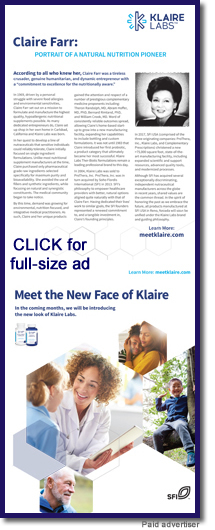Page 1, 2
Patient Reporting
What complicates this process is that these people are often quite ill to begin with. Frequently that affects their cognitive processing, memory, and brain function, as well as their attention to detail and in some cases their ability to keep track of their symptoms. Many of these patients have symptoms that vary across a range of severity from day to day, so they do not have a stable baseline. Consequently, it is difficult for some of the patients, particularly in the Lyme disease community, to determine whether a dose had an effect on them or not, and whether they are actually better or worse. Many will give me a report that goes something like this: "For a couple of days I felt worse and then for a couple of days I felt better,and then I felt worse again, and then better." Given that this is what they live with from week to week in any case, when they report that kind of up and down response after a dose, it probably means that the antigen itself had no effect. I prefer to then give them a little stronger dose to see if that causes a more obvious response from their baseline (i.e. 29C following 30C, etc.). But patients who are more fearful may interpret these "null" responses as "flares" and wish to back off to a weaker dose. One approach is to give progressively more diluted antigens through several dosing cycles of seven weeks each, moving away from the initial dose until it is clear that the dosage is not triggering a flare.
The interpretation of dose reports is the process we go through with every patient, case by case, week by week. This information is the basis used to determine adjustments in the dosage and therapy. The process is critical, and the success of LDI depends on how well the patient can perceive and interpret changes in their condition and report that back to the practitioner. There is no "protocol" for dosing LDI over time; it is 100% individualized, based on how the patient responds to every dose taken. There is never any plan beyond identifying the very next dose.
People in the Lyme disease population are the most complex patients I treat. Symptoms involving the same antigen may vary greatly from one patient to the next, one person suffering joint pain, peripheral nerve symptoms, numbness, and tingling and another struggling with headaches, brain fog, and night sweats. There is often a difference in the symptoms and response from one person to the next, even with the same antigen. Symptoms may be widely variable even in the same patient and require time to document carefully. That said, providers accustomed to careful symptom observation will find aspects of this approach fairly familiar.
 Flares Flares
There is always the possibility that the dosage we choose is too strong and may cause a flare in which related symptoms temporarily become worse rather than better. However, it is important to realize this is actually good news. It means that we have found an effective antigen mixture; and once the right dosage is identified, symptoms will get better. Although it is never the goal to cause a flare, when that happens it represents great progress.
One of the important concepts of LDI is the balance between the risk of a flare and the efficiency of the treatment. If the patient wants their answer quicker, they have to be willing to accept a higher chance of flaring. If they do not want a flare, they have to be willing to be patient. When our primary goal is to avoid a flare, we start the patient at a much weaker dosage, and it takes longer to find the effective dilution. However, we can move through progressively stronger doses every ten days until a beneficial response occurs. If you get a little over zealous and gives the patient a dose that is too strong and they flare, then you must wait seven weeks before giving another dose of that antigen. Consequently, there can be a longer delay recovering from a flare than there is when starting the dosage more conservatively.
I make an effort to avoid flares by building a 3C cushion into my estimation of the starting antigen dose. My rule of thumb is that flares tend to last roughly one week for every 1C we were off on the dilution. Information from the patient regarding the severity and duration of their flare is incredibly important in determining the right treatment for that person. I select the dose I think the patient will need based mainly on my experience with other people with the same condition and the severity of their symptoms. Then I start the patient at 3C weaker than the dosage I think they need, which gives me a larger margin of safety.
Long-Term Response
Many people obtain consistent relief from their full cycle dose within the first year. Hopefully everyone can maintain 100% symptom relief from then on. More than fifty years of EPD/LDA experience suggests that about one-third of patients are able to stop therapy after a matter of a few years and no longer need the antigens at all. It is too early to know if we will see similar success with the LDI autoimmune antigens. I think a key difference is that with LDI, we are often desensitizing patients to antigens that reside within their own bodies, antigens that cannot be avoided as external allergens can.
Typically, the duration of improvement becomes longer and longer with repetition of the correct dosage. Early on, people receive their dosage every seven weeks, but after approximately a year of treatment, for some patients we can space out the dosages to two, three, or four months so they only need a dose a few times a year. At that point, the therapy becomes lower maintenance and less expensive. A realistic expectation for everyone is that they only need a dose a few times a year; and I have developed methods for tweaking the dosage to achieve this in the great majority of patients. In conventional therapy, patients incur costs of hundreds of dollars per month. In contrast, maintenance dosing of LDI from my office should cost less than $500 per year.
The Art and the Science of LDI
The art of low-dose immunotherapy largely involves communicating effectively with the patient or their caregivers. Every adjustment in dose is based on how the patient responded to the previous dose. That requires a great deal of perception and effective description on the part of the patient. The practitioner needs to learn how to ask the right questions to gather the information needed to make good decisions. This skillset improves greatly with experience, but it can be frustrating. I equate learning LDI to playing an instrument. If you devote the proper time and focus, you can make "music" for many of your chronically ill patients.
Experienced integrative practitioners who have a broad knowledge base and have developed their skills in empirical clinical observation and/or other forms of immunotherapy often utilize this tool quite well. Those who are Lyme-literate are likely to be astute observers and bring the requisite skills to the table in order to learn this therapy easily. If they practice it effectively, they have the opportunity to have an impact on many complex debilitating disorders with a safe, highly successful, and inexpensive form of treatment.
Page 1, 2
Ty R. Vincent, MD
Dr. Ty Vincent grew up in Alaska, graduated from the University of Alaska, magna cum laude, and earned his medical degree at the University of Washington. A family practice physician in Alaska for more than a decade, Ty has been a board member of the American Academy of Environmental Medicine and the American College for the Advancement of Medicine. With diplomate status from the American Board of Family Medicine, he has also completed additional training and fellowships in environmental medicine, medical acupuncture, and Chinese herbal medicine. Recognized as an expert and innovator in the field of low-dose antigen therapy, he has received awards from the American Academy of Family Practice, the Society of Teachers of Family Medicine, and the American Academy of Environmental Medicine. Dr. Vincent now provides training for professionals and co-management of patient care through his company, Global Immunotherapy, LLC, based in Kona, Hawaii.
Resources
LDI Training and Clinical Services
Global Immunotherapy offers distance provider training and patient care. Patients receive consultations with Dr. Vincent by phone or Skype in the comfort of their own home. Provider membership enables practitioners to receive the LDI Training Manual and to order LDI antigens, as well as customized autologous samples. Membership facilitates direct contact with Dr. Vincent, answers questions about LDI, supports case review, and gives practitioners the opportunity to converse with other professionals who are using LDI treatment. Global Immunotherapy also provides LDI antigens for healthcare professionals, to be diluted and used for the treatment of their own patient populations. We have had very good success treating all manner of allergies, autoimmune diseases, and chronic inflammatory disorders. Dr. Vincent also provides consultations and patient co-management in conjunction with local primary care physicians on medical needs beyond the parameters of LDI.
Global Immunotherapy LLC, Kona, Hawaii, 907-671-8255
customerservice@globalimmunotherapy.com
Web-based Information
We now have a series of short video clips on YouTube and linked to our Facebook page and website. Most of the videos are brief, conceptual discussions of 5 minutes or less on different aspects of LDI therapy. We are finding that this is a very effective tool for helping patients work with their provider on LDI treatment, and at this point the videos have received more than 10,000 views.
globalimmunotherapy.com
Thinking Outside the Pill Box (available through Amazon, Barnes and Noble, Google Books, etc.)
LDA Providers
Dr. W. A. Shrader maintains a website listing physicians he has trained who administer LDA, alphabetical by state in the US, Canada, the UK, and elsewhere, available at www.drshrader.com/lda_physicians.htm.
Editorial: Nancy Faass, MSW, MPH
Ms. Faass is a writer and editor in San Francisco who has participated on more than 50 books to date. Director of the Health Writers' Group for the past 20 years, she works collaboratively with clients to develop books, articles, Web content, white papers, manuals, and blogs, and can be reached by emailing info@HealthWritersGroup.com or calling 415-922-6234.
|
![]()
![]()
![]()
![]()






